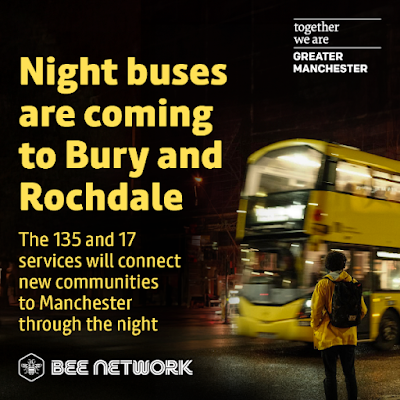Transdev Rolls Out £6.6m Electric Fleet on Bradford to Keighley Routes


Greater Manchester is set to strengthen its public transport offering with more night buses, new services, and increased frequency on key routes, as part of the ongoing expansion of the Bee Network. These improvements aim to support regional economic growth, enhance passenger convenience, and bolster the night-time economy.
 |
| Transport for Greater Manchester |
Despite national trends showing declining bus usage, Greater Manchester has bucked the trend with its Bee Network. Since the network returned to public control, the region has seen a 14% year-on-year increase in passenger numbers and a 7.8% rise in bus mileage in franchised areas. Unlike deregulated networks, which have historically shrunk, the Bee Network is proactively expanding services.
Andy Burnham, Mayor of Greater Manchester, said:“We have been on an incredible journey since the launch of bus franchising, with the Bee Network playing a vital role in making Greater Manchester the growth success story in the UK by providing a cleaner, greener and more affordable way to get around the region.
Public transport is one of seven key areas underpinning our future vision for Greater Manchester, and over the next decade we will continue to invest in the Bee Network and transform how people get around our city-region.
This starts by adding more night buses, higher frequency services and new routes, helping connect people to jobs, education and other opportunities across a growing and thriving Greater Manchester, so that everyone can live a good life.”
Key improvements due to begin later this year include new hourly night buses on routes connecting Manchester city centre with Bury (route 135) and Rochdale via Middleton (routes 17/17a). These routes specifically cater to areas with lower car ownership, improving accessibility to key employment sites and hospitality venues. Initially running on Thursday, Friday, and Saturday nights, these buses respond to peak demand at weekends.
Existing night services such as the V1 and 36, introduced as pilots, have been extended at least until 2026, reinforcing the network's commitment to sustainable night-time transport options. Further expansions are being explored for Oldham, Tameside, and Trafford, set to roll out by 2027.
 |
| Transport for Greater Manchester |
Wigan and Standish will also benefit from a new Bee Network service, the 631, launching in July. This daytime and evening route connects Wigan Bus Station and Standish Leisure Centre, serving crucial community locations such as Royal Albert Edward Infirmary and local schools and shops. This follows the successful introduction of the first Bee Network route (615), which connected Wigan to Middlebrook Retail Park.
Frequency enhancements are planned on major routes connecting Bolton, Leigh, and Manchester. Notably, the 582 service between Bolton, Atherton, and Leigh will increase to a bus every 10 minutes during weekdays and Saturdays, alongside better evening and Sunday services. Additionally, the Leigh Guided Busway will see frequency improvements, operating buses every four minutes during peak morning hours, with added afternoon services from Manchester.
Transport Commissioner Vernon Everitt described the improvements as essential steps to reverse historic declines under deregulation. He reaffirmed the Bee Network’s commitment to continually improving services based on community feedback, emphasising accountability to Greater Manchester’s residents.
Vernon Everitt, Transport Commissioner for Greater Manchester, said:“As the first area to bring buses back under local control we are taking bold steps to reverse decades of decline where, under the old deregulated system, too many routes and services were cut and communities left without access to public transport.
“The Bee Network works for, and is accountable to, everyone in Greater Manchester, and we are constantly using the feedback we are getting to make improvements.
“These latest proposals for later, more frequent and better-connected buses is further evidence of how we continuing to grow the network, but we know there is still more work to do.
“That is why we will focus on delivering the pledges set out in the Greater Manchester Strategy to ensure 90% of people are living within 400m – around a five minute walk – of a public transport service, connecting them to jobs, education and other opportunities.”
These ambitious proposals underline Greater Manchester’s goal to establish a fully integrated, zero-emission public transport system, aligning with its broader Greater Manchester Strategy. By enhancing frequency, reliability, and accessibility, the Bee Network aims to ensure every resident can access jobs, education, and leisure conveniently, sustainably and affordably.
Comments
Post a Comment
We welcome your thoughts and encourage open discussion but please keep comments respectful, relevant and considerate of others. Offensive, abusive or spam content will be removed and repeat offenders may be blocked. Let’s keep this space friendly and constructive for everyone.